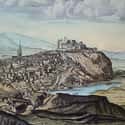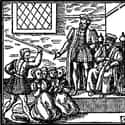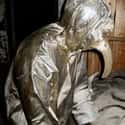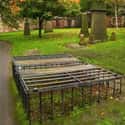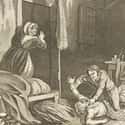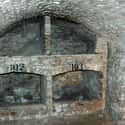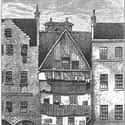-
(#1) A Ghost Bagpiper Lost Under Edinburgh Castle Still Haunts Its Tunnels
Edinburgh Castle is one of the oldest fortresses in Europe, dating back to the 9th century. It sits atop a hill overlooking Edinburgh, and underneath the castle, a network of tunnels connects it with the rest of the city. But some of the secret tunnels are more mysterious than others. Where did they lead? Did they make the castle vulnerable to a surprise invasion? To learn where the tunnels went, the Scots sent a young boy with bagpipes to investigate.
The boy played loudly as he walked deeper into the tunnel, and above ground, people used the sound to trace the tunnel's route. Then, the bagpipes suddenly fell silent. Search parties tried to find the boy, but he had vanished. Assuming he had perished, they blocked the tunnel. However, since 1650, people have reported hearing the ghostly sound of bagpipes from deep under the castle.
-
(#2) The Most Haunted Graveyard In The World Is In Edinburgh
Edinburgh's Greyfriars Kirkyard is home to half a million souls. And not all of its residents received fancy stone mausoleums. In some areas, the layer of dirt covering the caskets is so thin that bones occasionally poke through.
The cemetery's most famous ghost is George MacKenzie. During the 17th century, MacKenzie wreaked havoc on religious non-conformists in Scotland. After his passing, MacKenzie was buried in the Black Mausoleum. When an unsuspecting man opened the tomb in 1999, he reportedly released the MacKenzie Poltergeist, who still allegedly haunts Greyfriars Kirkyard.
-
(#3) The Black Dinner Inspired The Red Wedding
Edinburgh Castle hosted the bloody Black Dinner in 1440. That year, the powerful Chancellor of Scotland invited two young aristocrats over for dinner. The Earl of Douglas was 16 and his younger brother David was only 10. Although they were young, the chancellor worried of a challenge from the Douglas clan. As a result, he orchestrated an ambush on the young boys.
During the Black Dinner, the chancellor's men dropped the head of a black bull in the middle of the table. They then seized Douglas boys and removed their heads. The bloody dinner party inspired George R.R. Martin's Red Wedding in Game of Thrones.
-
(#4) The Wizard Of West Bow Haunts His Old House
According to legend, the Wizard of West Bow, AKA Major Thomas Weir, still haunts the city. In 1670, Weir spontaneously confessed to incest, bestiality, and the use of magic to communicate with spirits. Even though his friends tried to convince him he wasn't a witch, and a doctor declared him unstable, Weir insisted on his own guilt.
Weir received capital punishment for his deeds. After his passing, locals claimed his house was haunted. The stories included mysterious lights in the windows of Weir's home and the sound of distant music. And although the house was torn down in the 1800s, parts of Weir's haunted house were allegedly incorporated into a Quaker Meeting House. Now, according to at least one staff member at the Quaker House, Weir still haunts the area where his house once stood. Today, it's a toilet.
-
(#5) Edinburgh's Loch Was Full Of Human Remains
Edinburgh used to have its own loch. Resting at the bottom of the hill, Nor' Loch was essentially an open cesspit. Butchers dumped their waste into the loch and villains disposed of their victims in the murky waters. The city even tossed the remains of prisoners into the waters of Nor' Loch.
The ghosts of Mr. Sinclair and his two sisters were said to haunt the loch. In 1628, the siblings were taken into custody on charges of incest. The three were locked in a chest and thrown alive into Nor' Loch. Over two centuries later, workers uncovered a box sunk deep into the mud and found three skeletons inside.
-
(#6) A Headless Drummer Boy Haunts Edinburgh Castle
In addition to a ghost bagpiper, Edinburgh Castle is also home to a ghost drummer with a striking appearance: He's headless. According to legend, the headless drummer first appeared in 1650, when Oliver Cromwell invaded Scotland and eventually captured the castle after a long siege. The apparition reportedly warned people of the castle's fall. For centuries, the drummer appeared when the castle was in danger.
As for the ghost's identity or how he lost his head, no one knows.
-
(#7) King James Hunted Witches Who Still Haunt The City
Scotland hunted down as many as 200 witches during the North Berwick Witch Trials in the 1590s. And the trials were unusual for more than just their size. King James VI of Scotland was personally involved, punishing accused witches himself in Edinburgh Castle. The North Berwick event was just one of Scotland's many witch hunts - as many as 4,000 accused witches burned at the stake in Scotland.
The women detained by King James aren't the only witches who allegedly haunt Edinburgh Castle. The spirit of Janet Douglas, burned at the stake in 1537, has been spotted in the castle. And as many as 300 witches were and thrown into Nor' Loch.
-
(#8) Edinburgh Has A Friendly Ghost Dog
Not all of Edinburgh's ghost stories are scary. In fact, the story of Greyfriars Bobby is downright heartwarming. Greyfriars Bobby was a Skye terrier who has since been memorialized in a bronze statue outside Greyfriars Kirkyard. According to legend, Greyfriars Bobby was a loyal dog who visited his master's grave for 14 years. After his long vigil, Greyfriars Bobby was buried near his owner's grave.
Today, the loyal dog lends his name to a Scottish pub. He's also remembered in a children's book that claims the ghost of Greyfriars Bobby still walks the Kirkyard.
-
(#9) Edinburgh Has A Haunted Underground Street
When the plague struck Edinburgh in 1645, one unlucky street was condemned completely, leaving 300 residents abandoned in their homes. The tale of Mary King's Close has inspired many ghost stories, partly because of its eerie location today: The street is now underground. When the Royal Exchange was built in the 17th century, the Close was demolished and buried; however, the site still draws visitors.
During the plague, the Close's gates were locked, effectively quarantining its inhabitants. The abandoned Close was forgotten for centuries. Today, visitors can take a tour of the underground alley and learn of the many ghosts that are said to haunt the area. Mary King's Close has also been called Edinburgh's most haunted street.
-
(#10) Eerie Coffin Cages Protected Human Remains
Human organs were in high demand in Edinburgh. Anatomists working at the medical school needed cadavers to examine, but in the 19th century, dissection was still thought to damn your soul to hell. Since no one wanted to donate their remains to science, some industrious individuals dug up coffins and sold their contents to medical schools.
To protect their souls, Edinburgh's residents began using mortsafes, basically cages above their graves. The heavy iron apparatuses kept bodysnatchers away. Greyfriars Kirkyard, called the most haunted graveyard in the world, features multiple mortsafes around its many graves. The coffin bars are an eerie reminder of a time in Edinburgh's past when people sold cadavers on the black market.
-
(#11) Infamous Bodysnatchers William Burke And William Hare Hunted In Edinburgh
William Burke and William Hare turned bloodshed into a profitable business in 19th-century Edinburgh. The two got a taste of riches in 1827 when they sold the cadaver of a man who perished in Hare's boarding house from natural causes. The scheme quickly spiraled into a bloody spree, as the men began slaying the poor and elderly and poor.
Burke and Hare invited unsuspecting guests into the boarding house, offered them whiskey, and quickly suffocated them. Then they sold the cadavers to Edinburgh University. When they were caught, Hare turned on Burke, who received a capital sentence. After Burke was dissected, his skin was used to make a book.
-
(#12) The Eerie Vaults Under Edinburgh Are Full Of Ghost Stories
Hidden deep under the streets of Edinburgh, the South Bridge Vaults were home to social outcasts and dangerous crooks. The vaults were built in the 1700s as a series of chambers found within the South Bridge. The chambers became an underground city for smugglers and other lowlifes.
Brothels flourished within the hidden vaults, and bloodshed was common. Bodysnatchers William Burke and William Hare hid cadavers in the vaults, and the notorious duo also hunted for victims in the underground city, where missing people went unnoticed. Today, ghost tours bring visitors to the vaults to learn more about the area's eerie history.
In 2003, a BBC reporter interviewed one of the men responsible for excavating of the vaults; however, she was shocked to learn the audio was unusable thanks to what sounded like voice speaking in Gaelic.
-
(#13) People Were Locked Up To Perish In Plague Houses
Edinburgh survived many outbreaks of plague - even the deadly 1645 outbreak, which wiped out up to half the city's population. The city desperately tried to stop the spread of disease, issuing a quarantine for infected people. But that was just the start: On some streets, city officials took even more drastic measures.
In several areas, the city simply bricked up the homes of people suspected of carrying the plague. The victims were left inside to perish with no way of escaping. Just like the residents of Mary King's Close, the people who met their ends behind brick walls in Edinburgh have inspired their own eerie ghost stories.
New Random Displays Display All By Ranking
About This Tool
When people are intoxicated by the beauty and the long cultural history of Edinburgh, they may not remember that Edinburgh had a very dark history and various bloody stories in the past. This city sometimes happens weird haunted events or spooky events, but many people feel that this bloody history makes Edinburgh more attractive. Edinburgh Castle is one of the oldest fortresses in Europe, dating back to the 9th century.
Ancient cities, vicissitudes of castles, melodious bagpipes, etc., so many attractive things in the capital of Scotland, and these characteristic cultures have passed down countless rumors and legends about ghosts. From Edinburgh cemeteries to corpse trading, more about its dark history can be found with the random tool.
Our data comes from Ranker, If you want to participate in the ranking of items displayed on this page, please click here.















